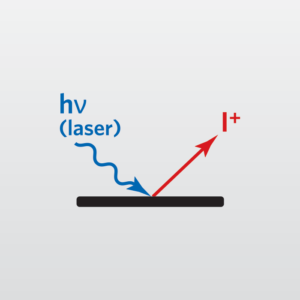Laser Ablation Inductively Coupled Plasma Mass Spectrometry (LA-ICP-MS)
Home » Our Techniques » Mass Spectrometry » LA-ICP-MS
Laser Ablation Inductively Coupled Plasma Mass Spectrometry (LA-ICP-MS) is an analytical technique that uses direct micro-scale sampling to provide high precision elemental and stable isotope analyses of solid materials.
LA-ICP-MS uses a powerful nanosecond-pulsed laser beam to remove material from the surface of a sample. The interaction of the laser and the sample surface causes heating, evaporation and ionization of sample material, in a process called “laser ablation.” A plume of particles and ions is generated and then carried via a constant flow of argon and/or helium gas to an ICP-MS.
The sample material is subsequently ionized in an inductively coupled plasma, and its atomic species are transported as ions, separated and analyzed based on their mass-to-charge ratio over time. LA-ICP-MS can therefore provide major and trace element compositions in a sample down to detection limits of 10’s of parts-per-billion (ppb).

LA-ICP-MS is considered extremely versatile, as the analyses can be performed on many solid materials without any preparation. Depending on the analytical measurement system, very small sample quantities (picograms to femtograms) may be sufficient for highly sensitive (parts per billion) survey analysis. Traditional liquid approaches for ICP-MS require milligrams of sample mass in order to be achieve this sensitivity. A range of laser spot diameters (5-200 µm) is available, allowing for spot and line sampling arrays over a maximum surface area of 10 cm2.
Ideal Uses of LA-ICP-MS
- Survey chemical analysis of solids
- Traceability (provenience) analysis
- Elemental or stable isotope distribution analysis
- Local inclusion and defect analysis
- Depth-specific multi-element chemical assay
Strengths
- Trace, minor, and major elements can be measured during the same analysis
- Microanalytical technique: Sample features 200 – 40 μm in size are routinely ablated, while features as small as 5 μm may be analyzed under some circumstances
- Qualitative, semi-quantitative, or fully quantitative data as needed
- Not limited by sample electrical conductivity, vacuum stability, inorganic/organic composition, or optical transparency/opacity
- Fast – no chemical preparation, clean – fewer opportunities for contamination, and green – no hazardous waste generated and minimal consumables used
- Polyatomic interferences caused by acid reagents and issues caused by the instability of some elements in dilute acid solution are both avoided
Limitations
- Requires matrix-matched, solid reference materials for quantitative analyses
- Not measurable: unstable radioisotopes, H, N, O, F, and noble gasses
- Internal standard element for data normalization cannot be added to most samples; a matrix element measured by a secondary technique or a pseudo-internal standard such as a gold sputter coating are required for most quantitative analyses
- Large and/or irregular samples may need mechanical preparation to fit in the laser cell
- Requires samples stable at room temperature and free of liquids for most applications
LA-ICP-MS Technical Specifications
- Species Detected: positive ions of stable isotopes
- Sensitivity: parts per billion (ppbw)
- Depth Resolution: 0.1 – 1 μm
- Typical Spot Size: 5 – 200 μm
Related Resources
Would you like to learn more about using LA-ICP-MS?
Contact us today for your Laser Ablation ICP-MS needs. Please complete the form below to have an EAG expert contact you.